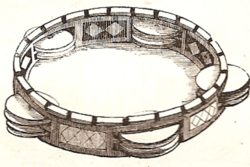The Orange on the Seder Plate
Holidays have always been crucial to my Jewish identity. Passover, as the only one I celebrate with my extended family, is particularly special. Each spring break I hear not only the expansive Exodus narrative, but also family stories and analogous Jewish accounts, all of which make up the significance of Passover in my life. There is one in particular that always stuck out to me, that felt more personal and more urgent as my grandmother would repeat it throughout the week: the story of the orange on the seder plate.
There are a few stories that you may have heard about the orange. They generally revolve around Susannah Heschel, a scholar and pioneer of Jewish feminism. The version I memorized from a young age claims that, after the death of her father Rabbi Abraham Joshua Heschel, Susannah Heschel attempted to join the minyan to say Kaddish for him and was told that a woman belonged in a minyan like an orange belongs on a seder plate. In reality, this encounter never happened; in fact, in my research, I couldn’t even find any references to it. It closely follows a more common origin story for the orange, in which a man asserts to Heschel that a woman belongs on a bimah like an orange belongs on a seder plate.
Growing up, I loved my grandmother's version of the story. I still do. The active inclusion of women’s history is beautiful and meaningful, especially incorporated into a ritual so central to my Jewish identity. And having spent time almost exclusively in Jewish spaces where sexism was not clearly visible to me, the reminder that it is still real within Judaism has been important in my consciousness.
But regardless of the importance of feminist symbols in our traditions, neither of those stories are the true origin of the orange on the seder plate. According to Heschel, the orange represents not the inclusion of women but of gay and lesbian Jews. As Heschel tells it, the idea originated from an early Jewish feminist practice she came across while speaking at Oberlin College, where some people would put crusts of bread on their seder plates, turning on its head the assertion that there is as much room for lesbians in Judaism as bread on a seder plate. Heschel was uncomfortable putting bread on her seder plate because it would violate the laws against eating leavened grains during Passover and because she didn’t want to suggest that gay and lesbian people are comparable to a Halakhic violation. Instead, she suggested an orange as a symbol of this inclusion, saying that it represents the fruitfulness of Judaism when gay and lesbian people are actively engaged and included. The orange also represents the oppression that LGBTQ+ people still face within the world and the Jewish community. According to Heschel, the seeds of the orange represent homophobia and symbolically spitting them out is a crucial part of the tradition.
When I learned the true story of the orange I was shaken. Queer history is so often erased, and the Jewish community is guilty of that. It is reaffirming to remember that there have been people fighting for LGBTQ+ Jewish inclusion and identity alongside people fighting for Jewish women in general. It is comforting to know that a woman with such a profound effect on modern Judaism was actively fighting for gay and lesbian inclusion.
But it is also frustrating to realize how Heschel’s intent has been erased. The symbolism of the objects on the seder plate is crucial to Passover. The establishment of an object that draws attention to the importance of gay and lesbian people in Judaism follows other modern traditions such as Miriam’s Cup which already represents the importance of Jewish women on many seder plates. The orange is a visible symbol that is significant not only for LGBTQ+ Jews, but for their families, friends, and the Jewish community in general. The progress of the Jewish community relies on not only accepting LGBTQ+ people, but on active and visible inclusion. Correcting the story of the orange is an important part of that.
Even after learning the true story, and believing in its importance, I am terrified to bring it up at my family celebration. While I want to do so, and even plan to do so, actually sharing it still feels like a big step. This symbol of women’s empowerment is clearly important to my family, especially my grandmother whose Jewish identity and life have been fundamentally shaped by the way her gender has restricted her. The history and empowerment of Jewish women are deeply important and personal to me and many of my family members. But the inclusion of LGBTQ+ Jews is equally important, and we cannot wait to fight for it. Waiting to correct this story and this inequality is unfair to our queer Jewish ancestors. It is unfair to those like Susannah Heschel who have fought for us. And it is unfair to LGBTQ+ Jews now. Choosing to tell the true story of the orange does not undermine the importance or urgency of Jewish feminism. No one should be asked to choose between their gender and their sexuality, just as no one should be asked to choose between their gender or their sexuality and their Jewishness.
(To hear more of the story behind the orange on the seder plate, including an interview with Susannah Heschel, check out our podcast episode An Orange Belongs on the Seder Plate Like...)
This piece was written as part of JWA’s Rising Voices Fellowship.







This was so well-said. The way you stood up for what you knew was right while also preserving the importance of the back story you grew up with is truly impressive.
Thank you for sharing this story! I'm very glad you gave voice to the origin of this practice. It is so important.